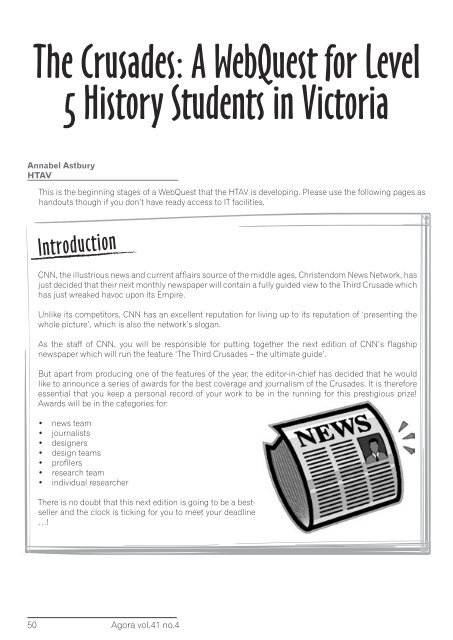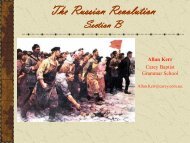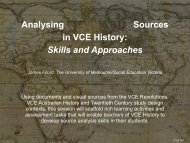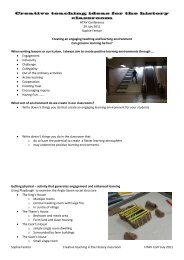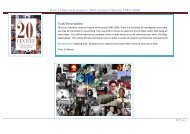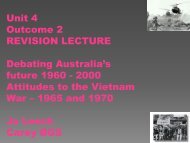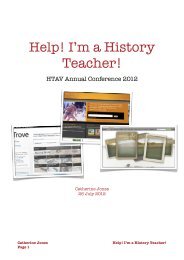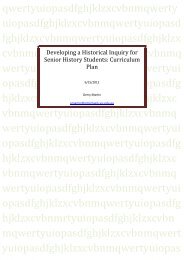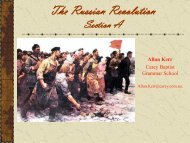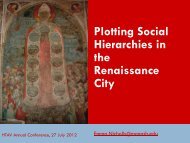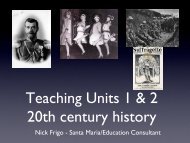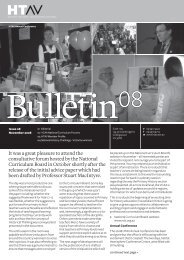The Crusades: A WebQuest for Level 5 History Students in ... - HTAV
The Crusades: A WebQuest for Level 5 History Students in ... - HTAV
The Crusades: A WebQuest for Level 5 History Students in ... - HTAV
You also want an ePaper? Increase the reach of your titles
YUMPU automatically turns print PDFs into web optimized ePapers that Google loves.
<strong>The</strong> <strong>Crusades</strong>: A <strong>WebQuest</strong> <strong>for</strong> <strong>Level</strong><br />
5 <strong>History</strong> <strong>Students</strong> <strong>in</strong> Victoria<br />
Annabel Astbury<br />
<strong>HTAV</strong><br />
This is the beg<strong>in</strong>n<strong>in</strong>g stages of a <strong>WebQuest</strong> that the <strong>HTAV</strong> is develop<strong>in</strong>g. Please use the follow<strong>in</strong>g pages as<br />
handouts though if you don’t have ready access to IT facilities.<br />
Introduction<br />
CNN, the illustrious news and current affiairs source of the middle ages, Christendom News Network, has<br />
just decided that their next monthly newspaper will conta<strong>in</strong> a fully guided view to the Third Crusade which<br />
has just wreaked havoc upon its Empire.<br />
Unlike its competitors, CNN has an excellent reputation <strong>for</strong> liv<strong>in</strong>g up to its reputation of ‘present<strong>in</strong>g the<br />
whole picture’, which is also the network’s slogan.<br />
As the staff of CNN, you will be responsible <strong>for</strong> putt<strong>in</strong>g together the next edition of CNN’s flagship<br />
newspaper which will run the feature ‘<strong>The</strong> Third <strong>Crusades</strong> – the ultimate guide’.<br />
But apart from produc<strong>in</strong>g one of the features of the year, the editor-<strong>in</strong>-chief has decided that he would<br />
like to announce a series of awards <strong>for</strong> the best coverage and journalism of the <strong>Crusades</strong>. It is there<strong>for</strong>e<br />
essential that you keep a personal record of your work to be <strong>in</strong> the runn<strong>in</strong>g <strong>for</strong> this prestigious prize!<br />
Awards will be <strong>in</strong> the categories <strong>for</strong>:<br />
•<br />
•<br />
•<br />
•<br />
•<br />
•<br />
•<br />
news team<br />
journalists<br />
designers<br />
design teams<br />
profilers<br />
research team<br />
<strong>in</strong>dividual researcher<br />
<strong>The</strong>re is no doubt that this next edition is go<strong>in</strong>g to be a bestseller<br />
and the clock is tick<strong>in</strong>g <strong>for</strong> you to meet your deadl<strong>in</strong>e<br />
…!<br />
50 Agora vol.41 no.4
praktikos<br />
<strong>The</strong> Task<br />
All journalists on the team will keep a record of their own work which covers the major tasks. <strong>The</strong>se tasks<br />
will <strong>in</strong>clude:<br />
A timel<strong>in</strong>e of events <strong>for</strong> <strong>The</strong> <strong>Crusades</strong> from 1009 C.E. to 1197<br />
An ‘overview’ section of the orig<strong>in</strong>s of the <strong>Crusades</strong>.<br />
A detailed profile of one of the key figures <strong>in</strong> the <strong>Crusades</strong>.<br />
*A description of battle <strong>in</strong> the crusade from A Christian’s perspective and a Muslim’s perspective<br />
(creative?)<br />
A 150 word sample of writ<strong>in</strong>g on the topic: Is it fair to say that the First Crusade be called the ‘People’s<br />
Crusade’?<br />
Specific directions <strong>for</strong> these tasks will be given <strong>in</strong> the section of the webquest called ‘details’.<br />
In addition to this record, all journalists will be required to be part of smaller news team, of which there<br />
will be four. Each team will be responsible <strong>for</strong> produc<strong>in</strong>g one section of the ma<strong>in</strong> feature. <strong>The</strong> four sections<br />
relate to:<br />
1. <strong>The</strong> orig<strong>in</strong>s of the Christian <strong>Crusades</strong> (1009 – 1075)<br />
2. Profiles of the key players <strong>in</strong> the lead-up to the <strong>Crusades</strong>.<br />
3. An outl<strong>in</strong>e of the ‘Council of Clermont’<br />
4. Events of the First Crusade (1095 – 1099)<br />
<strong>The</strong> specific responsibilities of each group are outl<strong>in</strong>ed <strong>in</strong> the section of the <strong>WebQuest</strong> called ‘Group<br />
Responsibilities’.<br />
Part One - Group Responsibilities<br />
As part of the ‘Essential Guide’ that you will be present<strong>in</strong>g, the chief editor has clearly stated that he would<br />
like the guide to consist of four sections: to give an overview of the orig<strong>in</strong>s of the <strong>Crusades</strong> (<strong>in</strong>clud<strong>in</strong>g key<br />
events lead<strong>in</strong>g to the crusades, brief profiles on the key players, maps of the area).<br />
1. <strong>The</strong> orig<strong>in</strong>s of the Christian <strong>Crusades</strong> (1009 – 1075):<br />
• Destroy<strong>in</strong>g of the Holy Sepulchre<br />
• Battle of Manzikert<br />
• Map of Christendom<br />
• Map of <strong>The</strong> Byzant<strong>in</strong>e Empire<br />
(<strong>The</strong> two team member responsible <strong>for</strong> the maps will also be responsible <strong>for</strong> present<strong>in</strong>g the f<strong>in</strong>al ‘look’<br />
of the section)<br />
2. Profiles:<br />
• Pope Urban II<br />
• Alexis I<br />
• Seljuk Turks<br />
• M<strong>in</strong>i Profile: Seljuk etc<br />
• Graphic Designer<br />
Agora vol.41 no.4 51
3. An outl<strong>in</strong>e of the ‘Council of Clermont’:<br />
• What the ‘Council’ was.<br />
• Who were the key participants?<br />
• <strong>The</strong> significance of the discussion at the Council<br />
• M<strong>in</strong>i-profile: Adhemar le Puy<br />
• Graphic Designer<br />
4. Events of the First Crusade (1095 – 1099):<br />
• M<strong>in</strong>i-Profile: Peter the Hermit<br />
• M<strong>in</strong>i Profile: Walter the Penniless<br />
• M<strong>in</strong>i-Profile:Godfrey de Bouillon<br />
<strong>The</strong> army commanders<br />
•<br />
•<br />
•<br />
•<br />
•<br />
•<br />
•<br />
M<strong>in</strong>i-Profile: Raymond IV of St Gilles, Count of Toulouse<br />
M<strong>in</strong>i-Profile: Bohemond, Duke of Taranto<br />
M<strong>in</strong>i-Profile: Godfrey of Bouillon<br />
M<strong>in</strong>i-Profile: Hugh, Count of Vermandois<br />
M<strong>in</strong>i-Profile: Robert, Duke of Normandy<br />
Map of the First Crusade: Nicaea, Dorylaeum, Edessa (Armenia), siege of Antioch, Jerusalem<br />
Conditions <strong>for</strong> the crusaders: <strong>The</strong> journey, Life on the battlefield: conditions, cloth<strong>in</strong>g, warfare<br />
Part Two - Individual Responsibilities<br />
To be <strong>in</strong> the runn<strong>in</strong>g <strong>for</strong> the various awards that the editor <strong>in</strong> chief has made on offer you must complete<br />
the follow<strong>in</strong>g <strong>in</strong>dividual assignments. You could be the next ‘Individual researcher of the year’ and enjoy<br />
the glory and accolades from the peers from around the world!<br />
1. A timel<strong>in</strong>e of events <strong>for</strong> <strong>The</strong> <strong>Crusades</strong> from 1009 C.E. to 1197<br />
You may present this task either as a l<strong>in</strong>ear timel<strong>in</strong>e which outl<strong>in</strong>es the ma<strong>in</strong> events of the orig<strong>in</strong>s of the<br />
crusades and the events of significance <strong>for</strong> the First Crusade, or you may like to organise it as part of a<br />
geographical timel<strong>in</strong>e, us<strong>in</strong>g a map to <strong>in</strong>dicate the location and description of the event.<br />
2. An ‘overview’ section of the orig<strong>in</strong>s of the <strong>Crusades</strong><br />
This section should be presented as a vertically oriented A3 page (just like a newspaper. It should <strong>in</strong>clude<br />
an overview of these events lead<strong>in</strong>g to the crusades:<br />
•<br />
•<br />
•<br />
Destroy<strong>in</strong>g of the Holy Sepulchre. (at least 75 words)<br />
Battle of Marzikert (at least 75 words)<br />
Council of Clermont (at least 75 Words)<br />
Of course, be<strong>in</strong>g an award-w<strong>in</strong>n<strong>in</strong>g newspaper, you will have snappy titles, stylish layout and <strong>in</strong>terest<strong>in</strong>g<br />
graphics like illustrations and maps.<br />
3. A profile of one of the key figures <strong>in</strong> the <strong>Crusades</strong><br />
This profile can be of any ONE person who played a significant role <strong>in</strong> either the lead-up to the <strong>Crusades</strong><br />
or the ‘First Crusade’. <strong>The</strong> profile should be at least 100 words long. Your profile should address these<br />
questions:<br />
•<br />
•<br />
•<br />
What did the person dur<strong>in</strong>g <strong>in</strong> the course of the crusade or the lead-up to it?<br />
What is the significance of their role? Why are they seen to be important when study<strong>in</strong>g this area?<br />
When was the person born? When did they die?<br />
Your profile should also <strong>in</strong>clude:<br />
• A picture or illustration where possible.<br />
• A quotation from a primary source which describes an aspect of the person or their actions.<br />
52 Agora vol.41 no.4
praktikos<br />
4. *A description of battle <strong>in</strong> the crusade from A Christian’s perspective and a Muslim’s<br />
perspective (creative writ<strong>in</strong>g)<br />
5. A 150 word sample of writ<strong>in</strong>g on the topic: To what extent was the First Crusade really the<br />
‘People’s Crusade’?<br />
<strong>The</strong> first th<strong>in</strong>g to remember <strong>in</strong> this task are the words ‘to what extent’ – <strong>in</strong> some ways this phrase is<br />
<strong>in</strong>vit<strong>in</strong>g you to look at both sides of the argument. So, your response may consider:<br />
•<br />
•<br />
•<br />
•<br />
Parts of the crusade that were really ‘the people’s’.<br />
Parts of the <strong>Crusades</strong> that weren’t really ‘the people’s’<br />
Evidence to support each of these views<br />
Your conclusion: yes or no?<br />
6. <strong>The</strong> <strong>Crusades</strong> and the Twenty First Century: How do the <strong>Crusades</strong> help us understand aspects<br />
of the world today?<br />
Aspects of the follow<strong>in</strong>g article may help you understand some of the long-term issues. Sumarise these<br />
<strong>in</strong> dot-po<strong>in</strong>t <strong>for</strong>m.<br />
<strong>The</strong> <strong>Crusades</strong>: A history of<br />
conflict<br />
Osama B<strong>in</strong> Laden has released a new audio tape describ<strong>in</strong>g<br />
Western policy towards the Muslim world as a “Zionist-<br />
Crusader war aga<strong>in</strong>st Islam”.<br />
B<strong>in</strong> Laden’s statement re-awakens a long-runn<strong>in</strong>g and<br />
controversial historical debate. Ill-judged Western<br />
references to the 200-year struggle between Christians<br />
and Muslims <strong>for</strong> dom<strong>in</strong>ation over the Holy Land <strong>in</strong> the<br />
Middle Ages have <strong>in</strong>flamed sensitivities <strong>in</strong> the Muslim<br />
world <strong>in</strong> the past.<br />
But what exactly were the <strong>Crusades</strong>, and what do they<br />
mean to us now?<br />
THE HISTORY<br />
<strong>The</strong> <strong>Crusades</strong> began <strong>in</strong> 1095 after Seljuk Turks took<br />
control of Jerusalem and began restrict<strong>in</strong>g access to<br />
Christian pilgrims. Pope Urban II called <strong>for</strong> a Christian<br />
army to retake the city from its Muslim rulers - spark<strong>in</strong>g<br />
a 200-year period <strong>in</strong> which parts of the Holy Land<br />
repeatedly changed hands, until the last crusade ended <strong>in</strong><br />
defeat <strong>for</strong> the Christians <strong>in</strong> 1291.<br />
Urban II saw the <strong>Crusades</strong> not only as a way of free<strong>in</strong>g<br />
the Holy Land, but also of extend<strong>in</strong>g the <strong>in</strong>fluence of<br />
the Roman Church <strong>in</strong>to the Byzant<strong>in</strong>e Empire - today’s<br />
Balkans and much of Turkey - through which the army<br />
would have to pass be<strong>for</strong>e reach<strong>in</strong>g Jerusalem.<br />
Glory and redemption<br />
<strong>The</strong> first Crusaders, who set off <strong>in</strong> 1096, were a motley,<br />
and ultimately unsuccessful, bunch - peasants, from<br />
France and Germany, spurred on by the prospect of more<br />
freedom. Hav<strong>in</strong>g pillaged and killed their way across<br />
Europe, they were vanquished by the Turks.<br />
Six months later a more professional army, compris<strong>in</strong>g<br />
French and Norman knights, set off. <strong>The</strong>y successfully<br />
stormed Jerusalem <strong>in</strong> July 1099, mak<strong>in</strong>g it one of four<br />
“Crusader states” <strong>in</strong> Syria and Palest<strong>in</strong>e.<br />
Serious trouble flared aga<strong>in</strong> <strong>in</strong> the early 12th Century<br />
when the Muslims took one of the other Crusader states<br />
<strong>in</strong> 1144, prompt<strong>in</strong>g the Second Crusade. However, its<br />
armies were almost wiped out <strong>in</strong> Asia M<strong>in</strong>or.<br />
Th<strong>in</strong>gs stepped up apace when the Turkish armies came<br />
under the command of Salad<strong>in</strong>, a Kurd, considered the<br />
greatest Muslim leader of the time. He reconquered<br />
Jerusalem prompt<strong>in</strong>g the Third Crusade, jo<strong>in</strong>tly led by<br />
Brita<strong>in</strong>’s best-known Crusader, Richard I or Richard the<br />
Lionheart.<br />
Although Richard and co failed <strong>in</strong> their prime goal - to<br />
snatch back Jerusalem - they defeated the Muslim <strong>for</strong>ces<br />
at nearby Acre and reached a peace with Salad<strong>in</strong> over<br />
Christian access to the Holy City.<br />
<strong>The</strong> Fourth Crusade, which started around the turn of<br />
the 13th Century, was a bit of a bungled affair, which<br />
ended with the warriors be<strong>in</strong>g excommunicated by Rome<br />
after they decimated the Catholic port of Zara on the<br />
Agora vol.41 no.4 53
Adriatic and fought Christians <strong>in</strong> Constant<strong>in</strong>ople <strong>in</strong> 1204,<br />
destroy<strong>in</strong>g valuable treasures.<br />
Th<strong>in</strong>gs reached another low with the Children’s Crusade<br />
of 1212, led by 12-year-old French peasant boy, Stephen<br />
of Cloyes, and a 10-year-old German boy, Nicholas. <strong>The</strong>y<br />
mobilised an estimated 50,000 children between them but<br />
both child armies were betrayed and taken <strong>in</strong>to brothels<br />
be<strong>for</strong>e leav<strong>in</strong>g Europe or sold as slaves at Alexandria.<br />
Another failed Crusade - the Fifth - followed, be<strong>for</strong>e<br />
Christians decided to switch tactics and try negotiation<br />
rather than brute <strong>for</strong>ce. <strong>The</strong> peaceful Sixth Crusade <strong>in</strong><br />
1228 restored Jerusalem to the Lat<strong>in</strong> world and a 10-year<br />
truce was signed. But th<strong>in</strong>gs fell apart when Muslims later<br />
reoccupied the city, prompt<strong>in</strong>g yet another Crusade <strong>in</strong><br />
1248. It collapsed when its leader, Louis IX of France, was<br />
captured. Two later <strong>Crusades</strong> both failed and the Turks<br />
took the last Christian stronghold <strong>in</strong> the region, Acre, <strong>in</strong><br />
1291.<br />
So how are these turbulent events viewed today, with the<br />
h<strong>in</strong>dsight of several centuries?<br />
MUSLIM PERSPECTIVE<br />
Traditionally, Muslims have not s<strong>in</strong>gled out the <strong>Crusades</strong> as<br />
a def<strong>in</strong><strong>in</strong>g moment <strong>in</strong> their history. <strong>The</strong> wars have generally<br />
been more of a Western obsession.<br />
“For most Muslims the <strong>Crusades</strong> were someth<strong>in</strong>g they won<br />
but just another <strong>in</strong>vasion among many <strong>in</strong> their history,” says<br />
Dr Jonathan Phillips, author of <strong>The</strong> Fourth Crusade and<br />
the Sack of Constant<strong>in</strong>ople.<br />
However, <strong>in</strong>terest <strong>in</strong> the <strong>Crusades</strong> has been renewed<br />
<strong>in</strong> recent years, with Osama B<strong>in</strong> Laden and his deputy<br />
Ayman al-Zawahiri repeatedly referr<strong>in</strong>g to them <strong>in</strong> taped<br />
messages.<br />
<strong>The</strong> BBC’s Islamic affairs analyst Roger Hardy says Osama<br />
B<strong>in</strong> Laden and his associates probably believe a straight<br />
l<strong>in</strong>e l<strong>in</strong>ks the <strong>Crusades</strong> with events of today.<br />
“<strong>The</strong> basic idea is that these enemies have always sought<br />
to attack and despoil Muslim lands. In B<strong>in</strong> Laden’s eyes,<br />
this was true of the early Crusaders who <strong>in</strong>vaded the Holy<br />
Land.<br />
“It was true of the European colonial powers and the<br />
Zionists who settled <strong>in</strong> what became the state of Israel. And<br />
he sees today’s latter-day crusaders, led by George Bush, as<br />
do<strong>in</strong>g essentially the same th<strong>in</strong>g,” says our analyst.<br />
Gaffes such as President Bush’s use of the word “crusade”<br />
as he launched the war on terror <strong>in</strong> 2001 played badly <strong>in</strong><br />
the Muslim world.<br />
“What is clear is that B<strong>in</strong> Laden is deal<strong>in</strong>g here with<br />
imag<strong>in</strong>ed history rather than with the facts documented<br />
by historians,” says Roger Hardy.<br />
“He is appeal<strong>in</strong>g to a k<strong>in</strong>d of Muslim folk-memory,<br />
sometimes with odd results. <strong>The</strong> Australians, <strong>for</strong> example,<br />
may feel that historically speak<strong>in</strong>g they hardly qualify as<br />
crusaders.<br />
“Nevertheless their role <strong>in</strong> help<strong>in</strong>g East Timor ga<strong>in</strong><br />
<strong>in</strong>dependence from Indonesia was seen by al-Qaeda <strong>in</strong><br />
that light - and used as one of the justifications <strong>for</strong> the<br />
Bali bomb<strong>in</strong>gs <strong>in</strong> 2002.”<br />
JEWISH PERSPECTIVE<br />
In northern Europe, the crusades crashed waves of<br />
violence upon the Jewish communities. Jewish people felt<br />
the brunt of the religious fervour that sent the Crusaders<br />
<strong>in</strong>to the Holy Land, says Prof Anna Sapir Abulafia of the<br />
University of Cambridge.<br />
Not only were they the most visible non-Christian<br />
community, says Prof Abulafia, but they also suffered<br />
because they generally weren’t rid<strong>in</strong>g off on crusade<br />
themselves and weren’t “part of all this non-Christian<br />
propaganda and hype”.<br />
In places like York, there was a massacre of the Jewish<br />
community <strong>in</strong> 1190.<br />
“If you start preach<strong>in</strong>g a Crusade and have accepted<br />
violence aga<strong>in</strong>st non-Christians... that then evokes all<br />
k<strong>in</strong>ds of violence aga<strong>in</strong>st Jews.”<br />
<strong>The</strong> New Jewish Encyclopaedia calls the crusades a<br />
“prolonged and bitter ordeal” <strong>for</strong> the Jewish community,<br />
say<strong>in</strong>g “thousands of Jews perished, and entire Jewish<br />
communities were wiped out. To this day, the Jewish<br />
liturgy conta<strong>in</strong>s prayers commemorat<strong>in</strong>g the martyrs of<br />
that dreadful period”.<br />
CHRISTIAN PERSPECTIVE<br />
<strong>The</strong> crusades made the news <strong>in</strong> 2000 <strong>for</strong> a simple reason:<br />
Pope John Paul II apologised <strong>for</strong> them. Sort of.<br />
54 Agora vol.41 no.4
praktikos<br />
<strong>The</strong> pontiff made a plea <strong>for</strong> <strong>for</strong>giveness of the past<br />
s<strong>in</strong>s of the Church, say<strong>in</strong>g, “We are ask<strong>in</strong>g pardon <strong>for</strong><br />
the divisions among Christians, <strong>for</strong> the use of violence<br />
that some have committed <strong>in</strong> the service of truth, and<br />
<strong>for</strong> attitudes of mistrust and hostility assumed toward<br />
followers of other religions.”<br />
It’s a commonly held view amongst moderate Christians<br />
that the <strong>Crusades</strong> are a shameful part of the religion’s<br />
history, experts say.<br />
However, some more conservative Christians side with<br />
the belief that the <strong>Crusades</strong> were a series of defensive wars<br />
aga<strong>in</strong>st Islamic aggression.<br />
Former presidential candidate <strong>in</strong> the US Pat Buchanan has<br />
said: “Now, we must also be ashamed of <strong>Crusades</strong> launched<br />
to recapture, <strong>in</strong> the name of our Lord, the Holy Land seized<br />
from Christendom by the armies of Islam.”<br />
Story from BBC NEWS: http://news.bbc.co.uk/go/pr/<br />
fr/-/2/hi/<strong>in</strong>_depth/4938202.stm<br />
Published: 2006/04/24 12:37:37 GMT<br />
Note to teacher: This article will need to be abridged and annotated <strong>for</strong> Year 8 students.<br />
Web L<strong>in</strong>ks - FOR STUDENTS<br />
Maps<br />
Europe, Byzant<strong>in</strong>e Empire etc.<br />
<strong>The</strong> <strong>Crusades</strong>: A history compiled by Boise State<br />
University<br />
http://crusades.boisestate.edu/pics/maps/<br />
Detailed Timel<strong>in</strong>es<br />
<strong>The</strong> <strong>Crusades</strong>: A history compiled by Boise State<br />
University<br />
http://crusades.boisestate.edu/timel<strong>in</strong>e/<br />
Images<br />
<strong>The</strong> <strong>Crusades</strong>: A history compiled by Boise State<br />
University<br />
http://crusades.boisestate.edu/pics/<br />
Read<strong>in</strong>g level: Beg<strong>in</strong>n<strong>in</strong>g<br />
Encarta<br />
http://encarta.msn.com/encyclopedia_761561210_<br />
1____8/<strong>Crusades</strong>.html#s8<br />
Timel<strong>in</strong>e of the <strong>Crusades</strong><br />
http://www.historylearn<strong>in</strong>gsite.co.uk/cru1.htm<br />
<strong>The</strong> First Crusade<br />
http://www.historylearn<strong>in</strong>gsite.co.uk/cru2.htm<br />
<strong>The</strong> First Crusade<br />
http://www.brighton73.freeserve.co.uk/<br />
firstcrusade/Overview/Overview.htm<br />
Christian vs. Muslim View of the <strong>Crusades</strong><br />
http://library.th<strong>in</strong>kquest.org/18110/content.<br />
htm?tqskip=1<br />
<strong>The</strong> Third Crusade<br />
http://www.historylearn<strong>in</strong>gsite.co.uk/third_crusade.<br />
htm<br />
Richard the Lionheart and Salad<strong>in</strong> – <strong>The</strong> Third<br />
Crusade<br />
http://www.historylearn<strong>in</strong>gsite.co.uk/Salad<strong>in</strong>.htm<br />
What was ga<strong>in</strong>ed from the <strong>Crusades</strong>?<br />
http://www.historylearn<strong>in</strong>gsite.co.uk/cru3.htm<br />
Concentric Castles: Legacy of the <strong>Crusades</strong><br />
http://www.historylearn<strong>in</strong>gsite.co.uk/concentric_<br />
castles.htm<br />
Mr Dowl<strong>in</strong>g’s Page on <strong>The</strong> <strong>Crusades</strong><br />
http://www.mrdowl<strong>in</strong>g.com/606islam.html<br />
Women and the <strong>Crusades</strong><br />
http://www.women<strong>in</strong>worldhistory.com/hero<strong>in</strong>e3.html<br />
Food of the <strong>Crusades</strong><br />
http://www.snunit.k12.il/njeru/ef41.htm<br />
Costume of the <strong>Crusades</strong><br />
http://www.snunit.k12.il/njeru/ef61.htm<br />
Agora vol.41 no.4 55
From Dr Helen Nicholson’s ‘FAQs’ on the<br />
<strong>Crusades</strong>:<br />
How many people went on the crusades?<br />
http://homepage.ntlworld.com/nigel.nicholson/hn/<br />
<strong>in</strong>dexFAQ.html<br />
Why did people go on a crusade?<br />
http://homepage.ntlworld.com/nigel.nicholson/hn/<br />
<strong>in</strong>dexFAQ.html<br />
Did women fight <strong>in</strong> the crusades?<br />
http://homepage.ntlworld.com/nigel.nicholson/hn/<br />
<strong>in</strong>dexFAQ.html<br />
Chivalry dur<strong>in</strong>g the <strong>Crusades</strong><br />
From the Catholic Encyclopaedia<br />
http://www.newadvent.org/cathen/03691a.htm<br />
Primary Sources<br />
Letters from Crusaders<br />
http://history.hanover.edu/project.html#ma<br />
Onl<strong>in</strong>e Activity: Fill the gaps<br />
<strong>The</strong> <strong>Crusades</strong><br />
http://www.schoolshistory.org.uk/islam1.htm<br />
Were the Arab armies successful?<br />
http://www.schoolshistory.org.uk/arabianarmies.<br />
htm<br />
Read<strong>in</strong>g <strong>Level</strong>: More challeng<strong>in</strong>g<br />
Overview: <strong>History</strong> Guide of the <strong>Crusades</strong><br />
http://www.historyguide.org/ancient/lecture25b.<br />
html<br />
Internet Medieval Sourcebook<br />
‘<strong>The</strong> <strong>Crusades</strong>’<br />
http://www.<strong>for</strong>dham.edu/halsall/sbook1k.html<br />
Onl<strong>in</strong>e Reference Book <strong>for</strong> Medieval Studies<br />
http://www.the-orb.net/encyclop/religion/crusades/<br />
crusade_<strong>in</strong>tro.html<br />
A <strong>History</strong> of the <strong>Crusades</strong><br />
University of Wiscons<strong>in</strong><br />
A history written from 1969<br />
http://digicoll.library.wisc.edu/cgi-b<strong>in</strong>/<strong>History</strong>/<br />
<strong>History</strong>-idx?type=browse&scope=<strong>History</strong>.<br />
Hist<strong>Crusades</strong><br />
Wikipedia: <strong>The</strong> First Crusade<br />
Selected sources and Read<strong>in</strong>g<br />
A list on onl<strong>in</strong>e resources (primary and<br />
secondary) relat<strong>in</strong>g to <strong>The</strong> <strong>Crusades</strong><br />
http://en.wikipedia.org/wiki/First_Crusade<br />
BBC Radio Programme<br />
“What If”: <strong>The</strong> First Crusade<br />
http://www.bbc.co.uk/radio4/history/what_<br />
if20020404.shtml<br />
<strong>The</strong> <strong>Crusades</strong> and the Present-Day<br />
Various News Articles Regard<strong>in</strong>g parallels<br />
between <strong>The</strong> Christian <strong>Crusades</strong> and the events<br />
called ‘<strong>The</strong> War on Terror’<br />
‘<strong>The</strong> <strong>Crusades</strong>: A history of Conflict’<br />
http://news.bbc.co.uk/2/hi/4938202.stm<br />
Background to the Hollywood film “K<strong>in</strong>gdom of<br />
Heaven”<br />
http://news.bbc.co.uk/2/hi/enterta<strong>in</strong>ment/4426133.<br />
stm<br />
‘A small matter of Crusader <strong>History</strong>’<br />
Discusses the Hollywood film ‘K<strong>in</strong>gdom of<br />
Heaven’<br />
http://news.bbc.co.uk/2/hi/middle_east/4544173.<br />
stm<br />
‘Film-maker defends <strong>Crusades</strong> epic’<br />
Responses to the film “K<strong>in</strong>gdom of Heaven”<br />
http://news.bbc.co.uk/2/hi/enterta<strong>in</strong>ment/4492625.<br />
stm<br />
‘West is on a Crusade – B<strong>in</strong> Laden’<br />
http://news.bbc.co.uk/2/hi/middle_east/4936284.<br />
stm<br />
‘<strong>Crusades</strong> and Jihads <strong>in</strong> Post-colonial times’<br />
http://www.bbc.co.uk/history/recent/sept_11/<br />
west_01.shtml<br />
<strong>Crusades</strong> and the “War on terror” – Reaction to<br />
President Bush’s use of the word ‘crusade’.<br />
http://www.csmonitor.com/2001/0919/p12s2-woeu.<br />
html<br />
56 Agora vol.41 no.4
praktikos<br />
Teachers’ Guide<br />
This quest is designed to comply with some of the learn<strong>in</strong>g outcomes <strong>for</strong> <strong>History</strong> <strong>Level</strong> 5 of the Victorian<br />
Essential Learn<strong>in</strong>g Standards curriculum design.<br />
<strong>The</strong> tasks <strong>in</strong>clude <strong>in</strong>dividual and group work assignments.<br />
<strong>The</strong> quest consists of two ma<strong>in</strong> themes:<br />
• <strong>The</strong> orig<strong>in</strong>s of <strong>The</strong> <strong>Crusades</strong><br />
• <strong>The</strong> First Crusade<br />
<strong>The</strong>se questions are then dealt with at more length to allow closer scrut<strong>in</strong>y of the events and impact of the<br />
<strong>Crusades</strong>.<br />
By the end of this quest, students should be able to answer the follow<strong>in</strong>g questions:<br />
• What were the orig<strong>in</strong>s of the Christian <strong>Crusades</strong>?<br />
• What were the key events and elements of the First Crusade?<br />
• How does the study of the <strong>Crusades</strong> help us understand the modern world?<br />
• What was the significance of this Crusade <strong>in</strong> the development of the modern world?<br />
It is expected that students will use a variety of resources and not just the ones presented here <strong>in</strong> this webquest<br />
but may <strong>in</strong>clude resources from their own textbook, if they have one, school and local libraries.<br />
<strong>The</strong> tasks are designed here so that students are able to demonstrate achievement <strong>in</strong> aspects of these<br />
standards:<br />
LEVEL 5<br />
Doma<strong>in</strong> Dimension Aspects<br />
<strong>History</strong><br />
<strong>History</strong><br />
ICT<br />
Th<strong>in</strong>k<strong>in</strong>g<br />
Historical<br />
Knowledge and<br />
Understand<strong>in</strong>g<br />
Historical<br />
reason<strong>in</strong>g and<br />
<strong>in</strong>terpretation<br />
ICT <strong>for</strong><br />
communicat<strong>in</strong>g<br />
Reason<strong>in</strong>g,<br />
process<strong>in</strong>g and<br />
<strong>in</strong>quiry<br />
Analysis and description of key events <strong>in</strong> Medieval Society<br />
Use sources to describe daily life<br />
Expla<strong>in</strong> key features of society: religious beliefs, <strong>for</strong>ms of cultural<br />
expression.<br />
How groups established and ma<strong>in</strong>ta<strong>in</strong>ed power<br />
Describe roles of key <strong>in</strong>dividuals and evaluate contributions and<br />
legacies.<br />
Comparison with present societies<br />
Key concepts: governance, power, religion<br />
Frame research questions<br />
Use of primary and secondary sources<br />
Analysis of resources<br />
Evaluation of sources<br />
Report on f<strong>in</strong>d<strong>in</strong>gs<br />
Locate and select relevant <strong>in</strong><strong>for</strong>mation<br />
Consideration of the po<strong>in</strong>ts of view made on the topic<br />
Agora vol.41 no.4 57
Communication<br />
Personal<br />
Learn<strong>in</strong>g<br />
Interpersonal<br />
Development<br />
<strong>WebQuest</strong>s<br />
Listen<strong>in</strong>g, view<strong>in</strong>g<br />
and respond<strong>in</strong>g<br />
<strong>The</strong> Individual<br />
Learner<br />
Manag<strong>in</strong>g<br />
Personal Learn<strong>in</strong>g<br />
Build<strong>in</strong>g social<br />
relationships<br />
Work<strong>in</strong>g <strong>in</strong> teams<br />
At <strong>Level</strong> 5, students modify their verbal and non-verbal responses to<br />
suit particular audiences. <strong>The</strong>y <strong>in</strong>terpret complex <strong>in</strong><strong>for</strong>mation and<br />
evaluate the effectiveness of its presentation. When respond<strong>in</strong>g, they<br />
use specialised language and symbols as appropriate to the contexts<br />
<strong>in</strong> which they are work<strong>in</strong>g. <strong>The</strong>y consider their own and others’<br />
po<strong>in</strong>ts of view, apply prior knowledge to new situations, challenge<br />
assumptions and justify their own <strong>in</strong>terpretations.<br />
students monitor and describe their progress as learners, seek and<br />
respond to feedback from peers, teachers and other adults and expla<strong>in</strong><br />
how their ideas have changed to develop and ref<strong>in</strong>e their content<br />
knowledge and understand<strong>in</strong>g.<br />
<strong>The</strong>y complete compet<strong>in</strong>g short, extended and group tasks with<strong>in</strong><br />
set timeframes, prioritis<strong>in</strong>g their available time, utilis<strong>in</strong>g appropriate<br />
resources and demonstrat<strong>in</strong>g motivation, use criteria to evaluate their<br />
work, and use these criteria to make appropriate ref<strong>in</strong>ements<br />
At <strong>Level</strong> 5, students demonstrate respect <strong>for</strong> the <strong>in</strong>dividuality of others<br />
and empathise with others <strong>in</strong> local, national and global contexts,<br />
acknowledg<strong>in</strong>g the diversity of <strong>in</strong>dividuals. <strong>The</strong>y recognise and<br />
describe peer <strong>in</strong>fluence on their behaviour. <strong>Students</strong> select and use<br />
appropriate strategies to effectively manage <strong>in</strong>dividual conflict and<br />
assist others <strong>in</strong> resolution processes<br />
At <strong>Level</strong> 5, students accept responsibility as a team member and<br />
support other members to share <strong>in</strong><strong>for</strong>mation, explore the ideas of<br />
others, and work cooperatively to achieve a shared purpose with<strong>in</strong> a<br />
realistic timeframe. <strong>The</strong>y reflect on <strong>in</strong>dividual and team outcomes and<br />
act to improve their own and the team’s per<strong>for</strong>mance.<br />
For more <strong>in</strong><strong>for</strong>mation on <strong>WebQuest</strong>s please see these l<strong>in</strong>ks:<br />
Bernie Dodge: http://edweb.sdsu.edu/webquest/necc98.htm<br />
Dr Alice Christie: http://www.west.asu.edu/achristie/675.wq.resources.html<br />
58 Agora vol.41 no.4
Assessment Guide<br />
praktikos<br />
Criteria Very Good<br />
<br />
Knowledge of<br />
the orig<strong>in</strong>s of<br />
the crusades<br />
and the First<br />
Crusade<br />
Congratulations! You have shown that<br />
you have a very detailed knowledge of<br />
the <strong>Crusades</strong>. You have shown this by<br />
<strong>in</strong>clud<strong>in</strong>g specific detail <strong>in</strong> your group<br />
and <strong>in</strong>dividual presentation. This<br />
would <strong>in</strong>clude accurate and detailed<br />
<strong>in</strong><strong>for</strong>mation about <strong>in</strong>dividuals and<br />
places <strong>in</strong>volved with the crusades.<br />
You have also used all the correct<br />
terms related to the <strong>Crusades</strong>.<br />
Use of<br />
resources to<br />
demonstrate<br />
knowledge and<br />
understand<strong>in</strong>g<br />
of the crusades<br />
Fantastic! You have used a wide<br />
variety of sources <strong>in</strong>clud<strong>in</strong>g reference<br />
books, the <strong>in</strong>ternet, sources written<br />
<strong>in</strong> the period. You have also used<br />
maps and visual sources to enhance<br />
your presentation. You have made<br />
accounts <strong>for</strong> why some sources differ<br />
from others. You are def<strong>in</strong>itely on your<br />
way to be an historian!<br />
Personal<br />
Learn<strong>in</strong>g &<br />
Teamwork<br />
What a team player!. You have worked<br />
very co-operatively with your team<br />
to produce a great presentation and<br />
have been a lead<strong>in</strong>g <strong>for</strong>ce br<strong>in</strong>g<strong>in</strong>g all<br />
the parts together. You have sought<br />
advice and <strong>in</strong>put from others when it<br />
was needed and have acted on that<br />
advice when appropriate. You have<br />
kept up to date with all tasks and have<br />
submitted it <strong>in</strong> on time. Well done!<br />
Communication<br />
& Presentation<br />
of In<strong>for</strong>mation<br />
Your presentation is very<br />
comprehensive, well-written and<br />
conveys mean<strong>in</strong>g clearly and is<br />
appropriate <strong>for</strong> the audience and task.<br />
You have presented your <strong>in</strong><strong>for</strong>mation<br />
<strong>in</strong> a visually creative and stimulat<strong>in</strong>g<br />
way. You have used IT to its best<br />
advantage when plann<strong>in</strong>g the design<br />
of your presentation or have worked<br />
through a few drafts to record your<br />
ideas.<br />
Good<br />
<br />
Good work! You have shown that<br />
you know a great deal about the<br />
<strong>Crusades</strong>. You have shown this by<br />
keep<strong>in</strong>g your <strong>in</strong><strong>for</strong>mation accurate.<br />
Sometimes you might have needed<br />
a bit more detail <strong>in</strong> some parts<br />
or may have needed to use more<br />
relevant terms and concepts <strong>in</strong> your<br />
presentation of <strong>in</strong><strong>for</strong>mation.<br />
Well done! You have used a variety of<br />
sources to support your knowledge<br />
and understand<strong>in</strong>g and have <strong>in</strong>cluded<br />
at least one primary source. You have<br />
also used at least one visual source<br />
to support your f<strong>in</strong>d<strong>in</strong>gs as well. Next<br />
time, when you use these pieces of<br />
evidence you might like to account <strong>for</strong><br />
why some are different <strong>for</strong>m the other.<br />
A good sport! You have worked well<br />
<strong>in</strong> a team environment, respect<strong>in</strong>g<br />
others’ po<strong>in</strong>ts of view and have<br />
been co-operative with other team<br />
members. You have submitted the<br />
major tasks on time and have <strong>in</strong> most<br />
cases managed the smaller tasks <strong>in</strong><br />
a timely manner. You have sought<br />
advice from the teacher when it was<br />
needed.<br />
Your presentation is well-written<br />
and conveys mean<strong>in</strong>g clearly and is<br />
mostly appropriate <strong>for</strong> the audience<br />
and task. You have presented your<br />
<strong>in</strong><strong>for</strong>mation <strong>in</strong> a visually stimulat<strong>in</strong>g<br />
way. You have used IT to create a<br />
basic plan <strong>for</strong> the design of your<br />
presentation or have worked through<br />
a few simple drafts to record your<br />
ideas.<br />
Satisfactory<br />
<br />
A solid ef<strong>for</strong>t! You have understood<br />
some of the ma<strong>in</strong> causes of the<br />
crusades and have shown that you<br />
know some key aspects of the First<br />
Crusade. Your response needed<br />
more explanation to show that you<br />
had really understood these po<strong>in</strong>ts<br />
though.<br />
Encourag<strong>in</strong>g! You have started to<br />
show signs of becom<strong>in</strong>g a good<br />
historian. You have used at least<br />
two resources to demonstrate<br />
your knowledge of the crusades.<br />
Next time you could try to <strong>in</strong>clude<br />
further comment on the sources<br />
you have used to demonstrate your<br />
understand<strong>in</strong>g of the event.<br />
You have worked with your team with<br />
some success. Not all parts of your<br />
work were submitted on time maybe<br />
because you did not prioritise some<br />
parts of the task. You sought advice<br />
from the teacher some times – but<br />
not <strong>for</strong>m your class mates.<br />
Your presentation looks attractive and<br />
is mostly suitable <strong>for</strong> the audience<br />
and the task that was set. Sometimes<br />
mean<strong>in</strong>g was lost because of the way<br />
you tried to present <strong>in</strong><strong>for</strong>mation. You<br />
<strong>in</strong>cluded very basic plans to design<br />
and record your ideas but might have<br />
been advantaged if you had used a<br />
graphic organiser or more detailed<br />
written plan.<br />
Needs significant improvement<br />
(Some knowledge or skills not shown)<br />
<br />
You need to revise some of the key<br />
po<strong>in</strong>ts of this unit. Your response<br />
presented <strong>in</strong>accurate facts and<br />
material. Sometimes you presented<br />
material that was not always relevant.<br />
Next time, you could try to crosscheck<br />
all of your <strong>in</strong><strong>for</strong>mation. Try to<br />
practise writ<strong>in</strong>g longer responses<br />
so that you can <strong>in</strong>clude much more<br />
detail.<br />
Un<strong>for</strong>tunately you haven’t used any<br />
resources to support you knowledge<br />
or understand<strong>in</strong>g of the crusades.<br />
Primary and secondary sources<br />
are the tools that historians use to<br />
support their f<strong>in</strong>d<strong>in</strong>gs – so it’s crucial<br />
that you use them.<br />
It is important that you try to submit<br />
all parts of your task and submit<br />
them on time – which you haven’t<br />
<strong>in</strong> this case. In the group situation<br />
you tended to work alone rather than<br />
as part of the team. Next time you<br />
could try to seek assistance from the<br />
teacher or others to guide you <strong>in</strong> your<br />
learn<strong>in</strong>g.<br />
More care could have been taken<br />
when you were plann<strong>in</strong>g and carry<strong>in</strong>g<br />
out the design of your presentation.<br />
<strong>The</strong> f<strong>in</strong>al product was not suitable<br />
<strong>for</strong> the <strong>in</strong>tended audience nor did it<br />
follow the <strong>in</strong>structions given <strong>in</strong> the<br />
task.<br />
Agora vol.41 no.4 59
Teacher Comment:<br />
Student Evaluation<br />
<strong>The</strong> parts of this task that I enjoyed most were:<br />
This was because:<br />
<strong>The</strong> parts of the task I had most difficulty were: (Choose as many as you like)<br />
This was because…<br />
Work<strong>in</strong>g with my group<br />
Keep<strong>in</strong>g to a deadl<strong>in</strong>e<br />
Present<strong>in</strong>g to the class<br />
Work<strong>in</strong>g on tasks by myself<br />
F<strong>in</strong>d<strong>in</strong>g <strong>in</strong><strong>for</strong>mation<br />
Other:<br />
To help me solve some of these problems, next time I could: (State three strategies only)<br />
1.<br />
2.<br />
3.<br />
60 Agora vol.41 no.4


